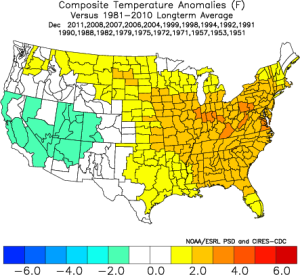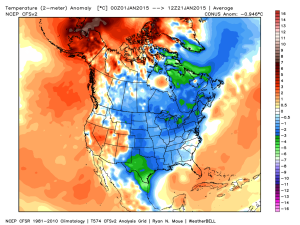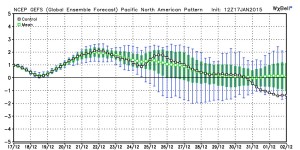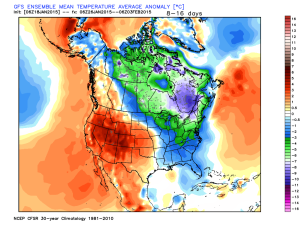You must be logged in to view this content. Click Here to become a member of IndyWX.com for full access. Already a member of IndyWx.com All-Access? Log-in here.
Category: AO
Permanent link to this article: https://indywx.com/welcome-to-meteorological-winter/
Nov 28
Iron Bowl Saturday: December Rambles…
This is a special day in the McMillan house. Iron Bowl Saturday only comes around one day a year… Needless to say, the Auburn flags have been on the vehicles since Wednesday, we’re decked out in our orange and blue, and game faces are on for this evening’s matchup. WAR EAGLE!
As we get set to flip the calendar to December, we wanted to post some latest thinking.
Let’s take a look at the latest teleconnections. As we’ve been talking, there’s a lot of “noise” in model land, including conflicting signals. The positive NAO and AO argue for warmer than average conditions, while the positive PNA suggests chillier than normal times should prevail.
We wanted to post the latest model predictions of each teleconnections, courtesy of Weatherbell.com. Additionally, courtesy of madusweather.com, here’s what each teleconnection “phase” would normally lead to in December.
NAO
AO
PNA

 Simply based on the teleconnections, you would build a December forecast that would lean more warm than cold, as the short term positive AO and NAO should trump the positive PNA. As we look at the month, as a whole, the AO and NAO are forecast to trend more neutral, while the PNA remains solidly positive. Does this suggest colder air, relative to normal, would invade mid and late month? – Certainly something to watch.
Simply based on the teleconnections, you would build a December forecast that would lean more warm than cold, as the short term positive AO and NAO should trump the positive PNA. As we look at the month, as a whole, the AO and NAO are forecast to trend more neutral, while the PNA remains solidly positive. Does this suggest colder air, relative to normal, would invade mid and late month? – Certainly something to watch.
Additionally, the latest Southern Oscillation Index (SOI), has begun to take a negative hit. This is after weeks of positive SOI values- relative to the base state.
While it takes a while to impact the pattern, locally, this negative hit does suggest mid and late month could be a bit more interesting from a wintry perspective. We shall see.
The CFSv2 remains very consistent on a warm month, relative to normal, particularly across the northern tier.
While we can’t post the European weeklies here, the latest run suggests colder, and stormy times around Christmas week. Now, we should also note the overall performance of the Weeklies hasn’t been as accurate compared to normal over the past few months, but it’s another interesting trend to keep an eye on.
The MJO will begin the month in Phase 3 before going into the “wheel house.” All-in-all, we don’t get a “hat tip” from the expected monthly MJO forecast, with the exception of Phase 3 to begin (warm phase).
 To sum up: Long range forecasting is always a gamble. Only the good Lord knows what the future holds. That said, there are times when we feel more confident about our long range, monthly outlooks, more so than normal.
To sum up: Long range forecasting is always a gamble. Only the good Lord knows what the future holds. That said, there are times when we feel more confident about our long range, monthly outlooks, more so than normal.
We’ll lean warmer than normal for December (+ 1.5 at IND), and this really plays into our Winter Outlook (slow start expected with the emphasis on the cold and snow mid and late winter), but that doesn’t mean we’re expecting a “boring” month. Keep in mind November has been both warmer AND snowier than normal, with a very busy 2nd half of the month.
We’ll have plenty of challenges to handle as we rumble through the month no doubt, but we expect the positive AO and NAO to trump the positive PNA to start to the month. As we progress into mid and late month, we’ll have to be on alert for potential impacts of that significant SOI hit to open the month. We’ll also keep the Weeklies in check to see if the colder, stormy look Christmas week remains. It’ll be fun, as always.
To close, here’s one more emphatic WAR EAGLE from our home to yours! 🙂
Permanent link to this article: https://indywx.com/iron-bowl-saturday-december-rambles/
Mar 04
Warm Up Coming…
After a long and cold winter, many are excited about hearing of the prospects of a warm up and first true taste of spring.
While the European data has totally bought in to the impressive “spring fling” next week, the GFS isn’t as excited of the potentially warmer times. Case in point, the GFS and European couldn’t be in more different camps for mid and late next week. Where the GFS has low/ mid 40s for highs the European has low/ mid 60s for highs. What’s 20 degrees amongst friends?!
Wild model swings and disagreements are common when pattern changes are taking place. While we might not get as warm as the Euro. would imply, it’s a safe bet we’ll be considerably warmer than the chilly GFS readings.
Note the AO and NAO strongly positive through the next 10-15 days. This is the time of the year when these teleconnections can impact our region’s weather in the most significant way. Both of these are warm signals taken at face value.
Note the pattern flip to a “flat” ridge by Day 10, indicative of the milder times ahead.
However, by Day 15 we notice the Alaskan ridge redeveloping. This is NOT a signal for warm weather across our part of the region, as the steering currents would tap available cold air and direct it south into the Mid West and Ohio Valley.
So, what do we take from this? We’re going to warm next week without question. While the extent of the warming is up for debate, the overall milder times for a 5-7 period is a good call at this point. On the flip side, we’re not ready to buy into the idea that spring is here for good just yet. The building Alaskan ridge by the end of Week 2 would imply a cold close to March, and potentially continuing into early April.
Another item to keep a close eye on the upcoming 4-6 weeks? Those NAO and AO signals. Should they remain predominately positive this time of year then it’ll be exceptionally challenging to get any sort of cold pattern to lock in for more than a day or two.
Permanent link to this article: https://indywx.com/warm-up-coming/
Jan 21
Facts Are Facts…
I’m hearing rumblings out there that you can’t get sustained cold across Indiana without a negative Arctic Oscillation (AO) and/ or negative North Atlantic Oscillation (NAO). I would ask those with that belief to please explain the following:
January temperature anomalies month-to-date show widespread cold (even accounting for the January thaw the past week).
The first two weeks of the month were downright frigid and this was in the face of an AO that was not just positive, but strongly positive.
To take this a step farther, the recent relative warmth has come with a negative AO.
Bottom line is that a ton of drivers are trying to take the wheel this winter. Admittedly, that makes things incredibly difficult for forecasting- short-term or longer range. That said, coming out with a “blanket statement” that you can’t have sustained cold without a negative AO or NAO is a flat-out lie and we wanted to address it. Teleconnections can help many times with coming weather patterns, but not always. This winter is a prime example of that.
Quick note on the clipper system- all forecast models today have taken the primary impacts (at least from a snow standpoint) north of the immediate region (central Indiana). Heaviest snows are favored across the Great Lakes, extending down into northern IN. We’ll continue to keep a close eye on things…
Permanent link to this article: https://indywx.com/facts-are-facts/
Jan 18
A Word On The Longer Range; Steady As She Goes…
We wanted to touch briefly on the longer range weather pattern as we’ve been answering questions this weekend out there concerning what lies ahead. Ultimately, the good Lord above is the only one who knows tomorrow and this idea we have very well may be the wrong one. However; we still see a lot of winter in this weather pattern. The combination of below average snowfall to date, combined with milder air the past 24 hours has led some winter lovers into a panic. Despite the past 24 hours, let’s remember where we are for the month of January through the first half:
Now let’s compare this to the infamous January 2014:
So far, this January the cold is more widespread across the nation. Additionally, through the first half of January, IND is actually running colder than last January. Many remember the brutal cold following the major winter storm early last January. Let’s also remember that a few days after that snow and cold we were dealing with much milder air and rain- a bonafide January thaw.
That brings us back to the present and our current January thaw. Looking back through the record books indicate even the coldest Januarys on record have “thaws.” What’s perhaps more impressive is that the end of this year’s thaw appears to be seen really before it even begins.
There are so many different drivers trying to take the wheel this winter it, admittedly, makes for an incredibly challenging time of things forecasting. That said, should we see the “stars align” (negative AO, negative NAO, positive PNA) in the coming weeks, this is the type scenario that could carry winter deep into spring.
In the shorter term, as of now we see no reason to abandon the idea the cold reloads to close January and open February. It’s possible that some weather outlets lean heavily on particular model runs and base their mid to long range forecast accordingly. While we agree you have to supplement some of that data into your mid and long range forecast, this is the type pattern than can make for risky business putting all the eggs in one basket. (We also suggest any outlets leaning solely on operational and ensemble output are in need for a serious dose of dramamine). Instead, we prefer a blend of the above with the foundation being a combination of a nearly ideal SST profile for wintry times continuing and big-hitter analogs. It must also be noted that we have to keep the current AO/ PNA state in the back of our mind.
Speaking of those teleconnections… The current AO and PNA leave a lot to be desired for winter lovers in the longer range:
That said, it should be noted the first two weeks of January cold was in the face of teleconnections that screamed of a warm pattern and a MJO phase that was also mild.
Perhaps the bigger driver here is the surface temperature profile in the PAC and ATL. Also note the modoki El Niño.
That warmer water sitting across the northeast Pacific Ocean promotes ridging into the PAC NW and AK. In return the upper level winds tap available arctic air and send it southeast (see the first two weeks of January).
In the mid range, ensemble data is bullish on this aforementioned pattern returning after the very brief January thaw.
The sensible weather that should result the upcoming 10-12 days? An active pattern and one that’s very challenging with that northwest flow (we’ll be on clipper watch), biased colder than average. In fact, the GFS ensembles aren’t too shy about eastern cold week 2.
Let’s watch things unfold in the coming couple of weeks. Make it a great day and GO COLTS!
Permanent link to this article: https://indywx.com/a-word-on-the-longer-range-steady-as-she-goes/






















